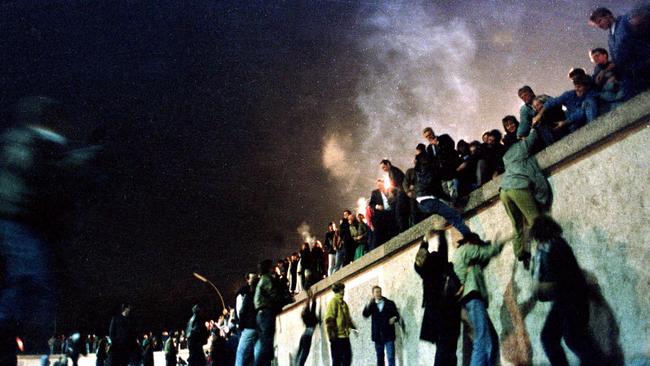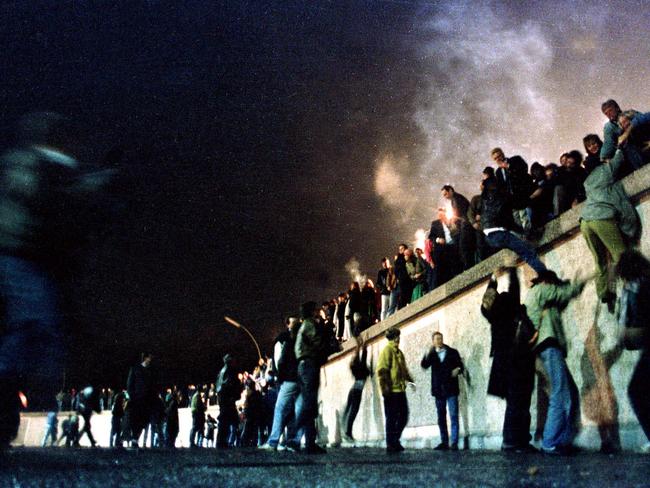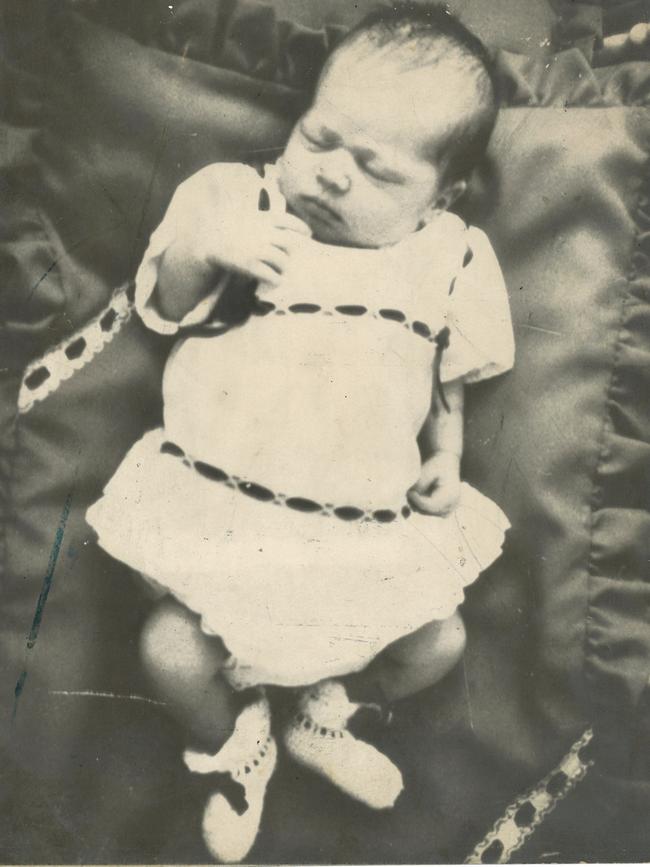‘Our most ambitious years underwritten by reckless optimism’
In this decade the nation was thinking big, had the people to match the dreams, and the bold banks to fund them. But it ended badly for some, for others even jail. We look back for this masthead’s 60th anniversary.

The Australian is turning 60 and we invite you to celebrate with us. Our first special series to mark the event is: Six Decades in Six Weeks, counting down to the 60th birthday of the masthead on July 15. Every day for the coming weeks we will bring you a selection of The Australian’s journalism of the past 60 years. Today we cover news. See the full series here.
In West Berlin, Nicolas Rothwell watched history happen before his eyes as the Berlin Wall suddenly lost its fearful purpose
WALL FALLS, HOPE RETURNS
- By Nicolas Rothwell. First published November 11, 1989

The spot-beams still slice through the night air; guards still stand alert in their watchtowers, staring out across a thin strip of no-man’s land; the barbed wire glints by the light of a clouded moon, while the shells of empty buildings mark the twisting boundary between East and West.
But all is changed, for this is the night the Berlin Wall lost its meaning. Suddenly, this purist symbol of totalitarian power, this badge of Cold War honour, has become a plaything, a quaint relic of a vanishing time – the last, most poignant casualty of glasnost.
Once, these fences, these yawning spaces between East and West Berlin, seemed as wide as eternity.
This was the barrier that measured the gap between hope and reality; here it was that men were transfixed by the unyielding spotlights, and gunned down trying to cross a thin street to freedom. Tonight, the intricacies of the wall, the care with which its towers are placed to see each snaking curve and sharp angled corner, seem no more than symptoms of the hysteria of the ideologues.
White and pristine snow on the eastern side, graffiti-strewn on the western, the wall has its own peculiar pathos. Perhaps one day it may even become a strange monument of history’s lost causes and fantasies, like the ruins of Troy or Jericho.
Now its time has passed, for yesterday evening, just as darkness settled over the divided city, the East German regime, tottering under the weight of popular protests and the constant outflow of its own citizens fleeing westwards, took the last gamble open to it.
The voice almost casual, slouched in his chair, the new information secretary of the Social Unity Party’s Politburo, Gunter Schabowski, announced that, effective immediately, all East Germans were free to cross the country’s borders.
In West Berlin, there was jubilation. The Mayor Walter Momper declared: “The wall no longer divides us.”
The announcement capped a hectic day of transformations and vital steps towards reform in East Germany. Political changes have reached their crescendo. Freedom of travel is the final step the party can take in order to persuade its people to remain in their own country, to persuade them to trust the sincerity of its sudden conversion to reform.
For the end of the wall, if East Germans do not halt their exodus, may also mark the end of East Germany. The ruling party also announced that it was now committed to holding free, democratic elections, with secret voting independently supervised.
THE ENDURING MYSTERY OF AZARIA
- By Errol Simper. First published September 16, 1988
There’s a certain difficulty in accepting that the Chamberlain case is over. For many, of course, an end there can never be. There is the film of the saga and all that tiresome cinematic hype yet to come. But an abiding mystery is left behind: what happened to Azaria?
What can be said is that with the quashing of the murder convictions against Michael and Lindy Chamberlain in Darwin yesterday, “the system” – so often questioned, insulted and vilified during the eight-year saga – can be said, after a fashion, to have worked. It is flexible. It can make mistakes. And it can admit them.
This may not in many ways be a great consolation to the Chamberlain family. Mrs Chamberlain spent nearly three years in jail for an alleged murder the system now says she did not commit. Her husband did not go to jail but he suffered a conviction and accusing fingers pointed his way.
The couple’s children, Aidan, Reagan and Kahlia, have suffered and will probably be scarred forever.
So far nothing but good appears to have come from last year’s decision by royal commissioner Justice Trevor Morling to the effect that if information available to him had been before the jury back in 1982 then Mrs Chamberlain would never have faced jail following the disappearance of 9½-week-old Azaria.
It is difficult to believe the story will ever fade totally from the media.

It will be particularly so because the overriding, central mystery – what actually happened to Azaria? – has, despite two inquests, a trial, two appeals and a royal commission, not really been solved. Mr Justice Morling stopped a deal short of finding a dingo did – as Mr and Mrs Chamberlain assume – take the child.
How did a dingo get the child from its Ayers Rock tent without at least leaving a trail of blood? How did it carry about one third of its body weight so swiftly and without dropping its burden, given that a justifiably alarmed Mrs Chamberlain chased it? How did it manage to consume the child without leaving any trace, not a sliver of bone, a hank of hair or a pool of blood?
How did a wild, ravenous animal manage to extract Azaria from her jumpsuit, nappy and jacket, yet contrive to leave the clothing in such a relatively undamaged condition? And why were the clothes in such an apparently neat pile when they were found a week after the baby disappeared?
They are factors that have always puzzled those involved with the case and it may be that we’ll now never know the answers.
Bob Hawke signalled Labor’s commitment to economic reform with his first cabinet, Russell Schneider commented, ahead of Andrew Peacock’s defeat of John Howard as opposition leader
PAS DE DEUX WITH BUSINESS
- Commentary by Russell Schneider. First published March 11, 1983
Mr Hawke’s carefully structured Labor cabinet represents a much greater threat to Mr Andrew Peacock’s hopes of winning the prime ministership than the vagaries of today’s Liberal Party meeting.
Mr Hawke has, in effect, put together the type of cabinet that would be the earmark of a Liberal government rather than a Labor one. The cabinet … is carefully structured to emphasise Labor’s concern with the economy, and the key ministers are men who want to stay in power and will do their best to work with industry and commerce.
Mr Hawke has paid lip service to the traditional Labor concerns with social issues. Gone are the days of the great social reform programs in which Labor cabinets and shadow cabinets were dominated by reformists. Mr Hawke has given some tokens: education is in the cabinet, with the only woman minister, Senator Ryan, in the top 13 decision-makers; and the only hard-line leftist to make cabinet is Mr West.
What Mr Hawke has done is to link immigration and education into the first framework of a manpower policy rather than putting these portfolios into cabinet for the sake of meeting the trendy demands of some Labor members.
The problem for Mr Peacock, or whoever wins the Liberal leadership today, will be matching Labor’s concern with economic affairs. The danger for the Liberals is that the natural dynamics of politics might force them to move further to the left and pick up the welfare area.
What an irony that would be – the ALP emerging as the businessmen’s party and the Liberals becoming the social reformers. But then again, who would have thought six weeks ago there would be an ALP cabinet in Canberra, let alone one going out of its way to woo the business community.
YOU ONLY GET ONE BOND
- Reflections by Alan Howe, history editor
By 1980, Australia was thinking big. We appeared to have the people to match those dreams – and bold banks to fund them. But much of this was underwritten by a reckless optimism and it ended badly for some, for others even jail.
It had looked like business as usual in 1980 when our challenge for the America’s Cup, sponsored by rising Perth businessman Alan Bond, was soundly defeated. If the fates pointed towards a brighter future, it was one of mixed fortunes. Three years later, the Australia II triumph off Newport, Rhode Island, was hailed in The Australian with the headline “Yes, we can do anything if we try”.
During that decade, Bond bought Swan Brewery, Tooheys, the Nine TV network, gold and nickel mines, CBD landmarks in Australia and Hong Kong, and Chile’s national phone network. With fanfare he purchased van Gogh’s Irises for the equivalent of $242m (but never paid up) while establishing our first private university. By the end of the decade his empire collapsed under the weight of unpayable debt, and he was later convicted of fraud, stripped of his Order of Australia and jailed.
Kerry Packer, who’d sold Nine to Bond and bought it back at fire-sale rates, famously said: “You only get one Alan Bond in your lifetime.” Australia had had its.
The world knows it as Black Monday, but the time difference saw the worst effects on Tuesday in Australia when jittery stock markets that had shed about 10 per cent in value the previous weeks went into free fall on October 20, 1987. On the Monday the Dow Jones Industrial Average dropped 22.6 per cent. In London, the market had been closed on the Friday after The Great Storm, a one-in-200-year event that killed two dozen people and felled 15 million trees. Over the Monday and Tuesday the FT 100 Index lost 23 per cent. Australian shares fell 25 per cent and in the following months values halved from their September peak. They took six years to recover.
The election of Bob Hawke in 1983 – he’d spent just 31 days as opposition leader – signalled a period of rapid and deep economic reform as Australia finally abandoned its protectionist stance, floated the dollar, deregulated the financial system and prepared the country for a role in the global economy. But no one saw 1987 coming.
It was especially bad for share prices of the celebrity CEOs in the club we remember as WA Inc. The Australian’s business columnist Terry McCrann summed up what happened as Brian Burke’s government cosied up to his state’s cowboy kingpins: “It was a disastrous combine of big government and favoured local main-chancers – notably Alan Bond and Laurie Connell – that turned the ‘decade of greed’ into a multibillion-dollar wipeout for WA taxpayers.”
Burke, Connell, former WA premier Ray O’Connor and former deputy premier David Parker – along with Bond – all spent time in jail.
The Soviet Union’s gerontocracy fell like dominoes to finally deliver the reformist whose changes would do the same to its iron-walled empire. The long-serving Leonid Brezhnev died in November 1982. His successor, Yuri Andropov, died in February 1984 having secretly spent almost his entire tenure in hospital. Konstantin Chernenko followed, but he died on March 10, 1985. The next day the little-known Mikhail Gorbachev, who had turned 54 the week before, was unanimously anointed leader. He had coined the term perestroika (restructuring) the year before. He added glasnost (openness) to it and the Berlin Wall lasted just four more years.
Over the British summer of 1980, the now King Charles became reacquainted with Diana Spencer, at the time a preschool teacher’s assistant. They’d met three years before when Charles dated Diana’s sister. Their romance whirlwinded across six months, and they married on July 29, 1981. After two children their strained union cracked and by 1986 both were having affairs, Charles returning to Camilla Parker Bowles, now his Queen.
Time Magazine named the computer as its “man of the year” in 1982 as technology – the emerging internet, and Apple’s first affordable and easy-to-use Macintosh computer launched in January 1984 – would confirm Joseph Schumpeter’s theory of creative destruction in which disruptive technologies destroy the past while building new futures.
The first mobile phone call in Australia was made on February 23, 1987 by communications minister Michael Duffy on a $4250 “brick” introduced by Telecom (now Telstra). By decade’s end 100,000 phones were on the network. As of March 2024 there were 31.9 million mobile phone connections.
